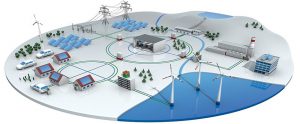Wind and solar wrestling coal into submission in Trump White House
Evolution of the American smart grid, falling costs for wind and solar, will carry the day
According to US media reports, the Trump Administration is split over renewable energy. One faction, led by EPA head Scott Pruitt, wants to end subsidies and policy support. The other, led by Ivanka Trump and her husband Jared Kushner, support renewables – which polls show are also favoured by many conservative Donald Trump supporters. My prediction? Pruitt et. al. will lose this fight. Clean energy technology is just too firmly entrenched in the rapidly changing American energy system.
“Seventy five percent of Trump supporters like renewables and want to advance renewables,” Debbie Dooley, a Tea Party organizer and solar energy activist, told a Bloomberg New Energy Finance conference in New York on Monday. “The conversation has changed. You have to have the right message. Talk about energy freedom and choice. The light bulb will go off.”
Dooley points out that market choice is a conservative value.
A Nov. poll commissioned by ConservativeEnergyNetwork.org found that over two-thirds of Republicans support an “all of the above” energy strategy, and would like to see more solar and hydro power added to the American energy mix. Hardcore conservatives favoured more emphasis on natural gas and soft conservatives favoured more wind, but coal received very little support from GOP voters.
As the poll indicates, power generation fuel sources get almost all the attention. But the real impetus behind the change in public attitude is the scope and intensity of the energy transition. Thousands of energy technologies are changing and evolving, becoming more integral to the everyday life of Americans.
Conservative voters may not understand the details, but they get the big picture (again, as illustrated by the poll).
That picture is quickly evolving and increasingly out of the control of the President, the White House, and even the federal government, largely because change is being driven by technology, not policy. In the case of renewables, not even so much by solar and wind generation as by the American power grids that distribute electricity to homes, businesses, and industry across the nation.
“The White House does not manage the power grid,” says energy economist Ed Hirs in an interview.
Increasingly, the power grid is becoming the “smart grid.”
A smart grid includes “the digital technology that allows for two-way communication between the utility and its customers, and the sensing along the transmission lines is what makes the grid smart,” according to the US Energy Dept. website.
“Like the Internet, the smart grid will consist of controls, computers, automation, and new technologies and equipment working together, but in this case, these technologies will work with the electrical grid to respond digitally to our quickly changing electric demand.”
The best analogy is the changes in telecommunications that started in the 1980s, when landlines dominated and cell phones were just hitting the market. Telcos re-engineered their networks to handle a multitude of communications technologies, from cell calls to texting to data to the internet.
 Utilities are re-engineering their power grids in much the same way. And the consequence, says policy analyst Nick Martin of the Canada West Foundation, is that markets – not politicians or public policy – will determine which power generation technologies supply electricity to the grid.
Utilities are re-engineering their power grids in much the same way. And the consequence, says policy analyst Nick Martin of the Canada West Foundation, is that markets – not politicians or public policy – will determine which power generation technologies supply electricity to the grid.
“Trump is push for revamping coal and it’s most likely not going to happen because coal decline wasn’t a policy issue, it was a market issue,” Martin said in an interview, referring to the rise of natural gas power generation in the last decade that was caused by low gas prices.
“It’s kind of the same thing with renewables. Once you unleash that market, it’s kind of out of your hands for where it goes.”
Martin argues that policy is still important to the efficient roll out of smart grids across the United States, but rules and regulations will be driven by state utility commissions, not Congress or the White House.
Hirs cautions that the evolution of the American smart grid will take many years, with some regions (e.g. California, New York, Texas) far ahead of other regions. He says there are 3,500 local and regional “actors” – utilities, balancing agencies, regulators, power suppliers, etc. – that somehow have to be coordinated so that the grid remains reliable and provides reasonably price power.
He wouldn’t let me pin him down on a timeline, but agrees that 10 to 20 years probably sounds reasonable.
Wind power not supplies five per cent of American electricity and according to levelized cost of energy studies from Lazard and the US Energy Information Administration, is competitive with natural gas combine cycle and new coal plants. Texas leads the states with 15 per cent wind and plans on installing more capacity in the near future.
Utility-scale solar accounts for one to one and a half per cent of American electricity, but is not yet competitive with natural gas and coal, but it is getting closer all the time and its cost curves are still dropping.
Which is why Scott Pruitt, and his allies like Attorney General Jeff Sessions, are going to lose the battle over renewable energy with Ivanka and Jared.
Markets rule in the US and the market is sending a clear message that renewables have their place in the American energy system, while coal does not.










If progressives want to put the final nail in the coffin of coal they should concentrate on those states that get over fifty percent of their power from coal and fund solar panel installation for low to moderate income households. At the least purchase energy-efficient appliances and ac units for said low to moderate income households. Less demand for energy means less coal mined and burned.
Sustainability and green should also equate to economically viable.
As this article states “Utility-scale solar accounts for one to one and a half per cent (1 to 1.5%)of American electricity, but is not yet competitive with natural gas and coal,”.
Although green costs are dropping dramatically, obviously costs have a long way to go. 24/7 supply is essential to economical viability and despite the leaps in storage capabilities 24/7 capability remains an unrequited dream.
Who cares how the electricity is generated as long as it is economical and competitive?
This is where all the arguments for and against need to come together.
Unfortunately, everyone is so busy bashing anything derived from fossils fuels that they fail to see the forest for the trees.
The more interesting economic issue is advancement in solar technology. The cost per megawatt, for solar, without subsidies, is approaching coal. Further, the cost curve, per megawatt for solar continues to decline and shows no signs of slowing while coal and nat gas (other than cheap natural gas at present) are essentially flat. It will not be long before solar production costs will be below coal and nat gas. Just like current commercial power producers are switching to nat gas purely from a cost perspective, the same will occur with solar. Coal producers are fighting a losing battle, simply on a dollar cost basis, and they know it.